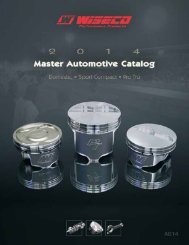CompleteCatalog
CompleteCatalog
CompleteCatalog
You also want an ePaper? Increase the reach of your titles
YUMPU automatically turns print PDFs into web optimized ePapers that Google loves.
Cylinder<br />
Honing Procedure<br />
Cast Iron Sleeved Cylinders: To ensure proper ring seal, it is necessary to hone the cylinder with a rigid or<br />
brush hone. DO NOT install a new piston without honing the cylinder to break the glaze. Finish hone with<br />
a 280 grit. Cross hatch is necessary to ensure proper ring seal and adequate lubrication. If the cylinder<br />
is in good condition, simply honing the cylinder may be enough to restore the bore to an acceptable<br />
condition. However in some cases, boring may be necessary to insure the cylinder bore is within the<br />
tolerances outlined in the service manual.<br />
Plated Cylinders: (Includes nickel ceramic coatings (Nikasil), chrome, Electrofusion, and boron composite.)<br />
If the plated cylinder is in good condition, honing may not be necessary. If deglazing is necessary, DO<br />
NOT use a ball hone. Use a rigid or brush type diamond hone. Plated cylinders cannot be bored oversize<br />
without replating or resleeving.<br />
Any time a cylinder is bored or honed: All ports must be chamfered. The top of the cylinder should be<br />
deburred, and the bottom should be generously chamfered for ease of piston and ring installation. When<br />
boring a cylinder with an exhaust bridge, the face of the bridge must be relieved .002”-.004” to allow for<br />
bridge expansion. Without proper bridge clearance, engine damage could occur.<br />
IMPORTANT: After honing, the cylinder must be washed with warm soapy water to remove all honing grit. Be<br />
sure to wash away any grit that may have traveled into the transfer and exhaust ports during honing. The<br />
cylinder is NOT clean until you can wipe the cylinder wall with a clean, oil dampened cloth and it does not<br />
pick up any honing grit. Lightly oil the cylinder bore to prevent oxidation and assist with piston installation.<br />
Exhaust Power Valves (2-Stroke engines): When boring cylinders with exhaust power valves the exhaust<br />
power valve must be 0inspected to ensure it does not extend into the cylinder. The exhaust power valve<br />
must have approximately .015” clearance from the cylinder bore. Without proper clearance, the exhaust<br />
power valve could contact the piston and engine damage could<br />
occur. If machining the exhaust power valve is necessary,<br />
remove metal only in the area that extends into the cylinder<br />
bore. (See illustration)<br />
Remove this material<br />
Electronics<br />
Fuel<br />
Management<br />
Crankshafts<br />
Cams/Valves<br />
Clutch<br />
Top End<br />
Can-Am<br />
ATV<br />
European<br />
Dirt<br />
Street<br />
Honda<br />
Dirt<br />
ATV<br />
Street<br />
Kawasaki<br />
KTM<br />
Dirt<br />
ATV<br />
Street<br />
Dirt<br />
ATV<br />
Street<br />
Polaris<br />
HONING BRUSHES<br />
Nylon Soft Hone Brushes<br />
Bore Range<br />
mm<br />
Bore Range<br />
Inches<br />
Part No.<br />
Brush<br />
O.D.<br />
Overall<br />
Length<br />
Price<br />
45-57mm 1.77”-2.24” W6075 2” 10” $49.40<br />
57-70mm 2.24”-2.76” W6076 3” 10” $49.40<br />
63-76mm 2.48”-2.99” W6077 4” 14” $64.73<br />
76-89mm 2.99”-3.50” W6078 4” 14” $64.73<br />
89-102mm 3.50”-4.02” W6079 4” 14” $72.83<br />
ATV<br />
Suzuki<br />
Dirt<br />
ATV<br />
Street<br />
Yamaha<br />
Dirt<br />
ATV<br />
Street<br />
PWC<br />
Sleeves<br />
Rings<br />
Accessories<br />
Apparel<br />
Visit wiseco.com for on-line ordering, tech info & updates • 800.321.1364 127



